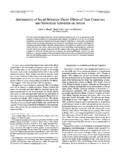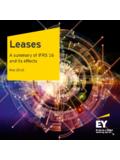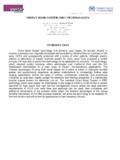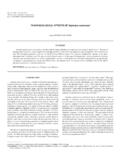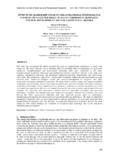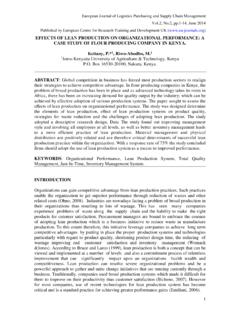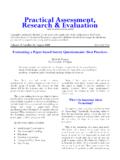Transcription of Globalisation’s Direct and - OECD
1 Global Forum on Transport and Environment in a Globalising World 10-12 November 2008, Guadalajara, Mexico globalisation s Direct and Indirect Effects on the Environment Carol McAusland, University of Maryland, the United States 2 FOREWORD This paper was prepared by Prof. Carol McAusland of the University of Maryland in the United States, as a contribution to the OECD/ITF Global Forum on Transport and Environment in a Globalising World that will be held 10-12 November 2008 in Guadalajara, Mexico. It discusses the Direct and indirect effects of globalization on the environment. It is meant to set the stage for subsequent discussions of the impacts of globalization on the activity levels of various transport modes and/or the environmental impacts of the changes in activity levels. 3 TABLE OF CONTENTS NOTE FROM THE SECRETARIAT .. 2 GLOBALIZATION S Direct AND INDIRECT EFFECTS ON THE ENVIRONMENT.
2 5 1. Introduction .. 5 2. Growth of Trade and FDI .. 5 3. Globalization s impact on the environment Early Research .. 6 4. Globalization s indirect effects .. 7 5. The Composition effect .. 7 6. Global Net Composition effect .. 10 7. Technique effect .. 11 8. Technique effect Income .. 11 9. Scale effect .. 15 10. Technique effect Environmental Politics .. 15 11. Technique effect Technology 16 12. Technique effect trade induced innovation .. 17 13. Globalization and the Environment Direct Effects .. 17 14. Surface Transport .. 18 15. Shipping Related Emissions .. 18 16. Biological invasions .. 19 17. Conclusions .. 20 REFERENCES .. 22 4 5 GLOBALIZATION S Direct AND INDIRECT EFFECTS ON THE ENVIRONMENT 1. Introduction 1. For over a quarter century researchers have been cognizant of the potential for the rise in trade to negatively impact the environment. Highly publicized events such as the fate of the Khian Sea,1 the leak of an internal World Bank memo signed by Chief Economist Lawrence Summers (in which Summers appeared to urge World Bank economists to encourage pollution intensive industry migrate to developing countries2), and riots at the 1999 World Trade Organization meetings in Seattle, brought the question of whether the surge in international trade is good or bad for the environment onto the world stage.
3 2. Over this quarter century, research into the net effect of globalization on the environment has matured, although there remain many outstanding questions. Moreover, there has been little (to no) effort exerted at linking up the two broad literatures concerning the Direct and indirect effects of globalization on our natural environment. The Direct effects include emissions and environmental damage associated with the physical movement of goods between exporters and importers. This includes emissions from fossil fuel use, oil spills, and introductions of exotic species. At the same time, growth in trade and foreign Direct investment has numerous indirect effects. These indirect effects are often classified as falling under one of three categories: the scale, composition and technique effects. I begin this chapter with a summary of patterns and rates of growth in international trade and foreign Direct investment (FDI), followed by an overview of early research into the relationship between globalization and the environment.
4 I then offer a summary of extant knowledge of globalization s indirect effects, focusing largely on current estimates of the size of the scale, composition and technique effects. I conclude the chapter with a brief discussion of the various Direct effects of globalization, notably transport related emissions and biological invasions, and attempt, however modestly, to put these into the broader context of overall effects. 2. Growth of Trade and FDI 3. Trade has grown substantially over the past 50 years, both in value and volume. Between 1951 and 2004, the average annual growth rate of world trade (by tonnage) was ; when measured by present value, the average growth rate was (Hummels, 2007, p. 133).3 Projections are for continued 1 The Khian Sea was a ship flying a Liberian flag that was hired to take incinerator ash from Philadelphia, USA to dump at a (manmade) island in the Bahamas.
5 The local government refused dumping permission and the ship began a 16 month journey which included requests to unload the ash in the Dominican Republic, Honduras, Panama, Bermuda, Guinea Bissau, the Dutch Antilles, Senegal, Morocco, Yugoslavia, Sri Lanka, and Singapore, all of which were denied. Some ash was unloaded in the Bahamas under a false label (as topsoil) and the rest was later admitted to have been dumped into the Atlantic and Indian Oceans. (Sinha 2004 and Wikipedia.) 2 Although Summers took responsibility for the memo, it was originally written by staff economist Lant Pritchett who claimed editing of the memo prior to its leak changed its tenor. See Harvard Magazine, May-June 2001 for an interview with Pritchett. 3 Growth rates vary considerably by country. According to the World Bank Trade Indicators ( ) in the 2005-2006 period, the countries experiencing the fastest real growth in total trade in goods and services were Mauritania ( ), Iran ( ), Azerbaijan 6 strong growth.
6 Using a gravity model of trade, based on measures of economic, geographical, political and cultural variables over the 1948 to 1999 period, Hamburg Institute of International Economics (HWWI) forecasts trade value among industrialized countries to grow at per annum until 2030, while trade within South Asia, East Asia and Pacific, and Latin America is projected to grow at , , and per annum respectively (Berenburg Bank & HWWI, 2006). 4. Foreign Direct Investment (FDI) has also been growing at a rapid pace. Between 1986 and 2000, 65 countries saw inward FDI grow by 30% or more; the growth rates in 29 other countries ranged between 20 and 29% (UNCTAD, 2003). FDI has increased most quickly for industrialized countries. Regarding inward FDI, during the 1998-2000 period just three regions accounted for over three-quarters of global inward FDI and 85% of global outward FDI: the European Union, the United States and Japan; as a whole, developed countries account for more than 75% of global inward FDI (UNCTAD, 2003).
7 5. There are a number of causal factors behind the growth of trade and FDI. Bilateral and multilateral negotiations have reduced average tariff rates on manufactured goods to in high income countries, in middle income countries and in low income countries 4 (World Bank, 2007). At the same time, technological improvements have lowered shipping and communication costs. 3. Globalization s impact on the environment Early Research 6. The earliest empirical research on how globalization impacts the environment tended to ask the reverse question: how does environmental regulation impact trade? The prevailing wisdom was that, if trade impacts the environment, it must be the case that environmental regulation affects trade flows; only then would the argument that trade worsens the environment by shifting pollution intensive production to low-regulation (and often low-income) countries make sense.
8 This proposition that globalization facilitates the relocation of dirty industry to poor countries is known as the Pollution Haven Hypothesis (PHH). 7. The earliest empirical work found little evidence in support of a PHH. In fact, by the time of Levinson s 1997 survey, the general consensus was that, while the PHH was theoretically persuasive, the data just didn t support it. 8. Nevertheless, subsequent empirical research has found evidence of a weaker relationship between regulatory stringency and trade patterns and volumes, known as the Pollution Haven effect (PHE). The PHE is the hypothesis that stringent environmental regulation impacts comparative advantage at the margin, but that it does not necessarily lead to a wholesale migration of industry to regions with weaker regulation. This research has focused on providing econometric solutions to problems plaguing the early studies, most notably the endogeneity of regulation, trade flows, and investment in the first place.
9 For example, Levinson and Taylor (2008) examine the relationship between industry spending on abatement and pollution control and import penetration (measured as the sum of imports and exports as a ratio to total domestic output) in the United States. Amongst other things they find industries whose abatement costs increased most experienced the largest increases in net imports, and that for the 20 industries facing the largest relative pollution control costs, more than half of the increase in trade volume can be attributed to ( ), Vietnam ( ) and China ( ).The countries with slowest trade growth are New Zealand ( ), Chad (-4. 8%), Benin ( ), Senegal ( ), Tunisia ( ) and Syrian Arab Republic ( ). Trade growth rates for the United States, Canada and Mexico were , , and 4 Rates given are weighted mean tariffs for manufactured products.
10 For countries reporting, the lowest mean tariff rate on manufactures is (Singapore), the highest (Bangladesh). Other rates are as follows: Canada ( ), China ( ), the European Union ( ), Japan ( ), Mexico ( ), USA ( ). (World Bank, 2007) 7 changes in domestic regulation. Similarly, Ederington et al. (2005) use panel data on import penetration and find that import penetration is higher for industries with high pollution abatement and control expenditures (PACE) (relative to total costs), and that this correlation is stronger for industries protected by import tariffs. They also find that the pro-import effect of tariff reductions is stronger for clean industries than for dirty ones. They conclude that if anything, trade liberalization has shifted industrial composition toward dirtier industries, by increasing imports of polluting goods by less than clean goods (p.)










